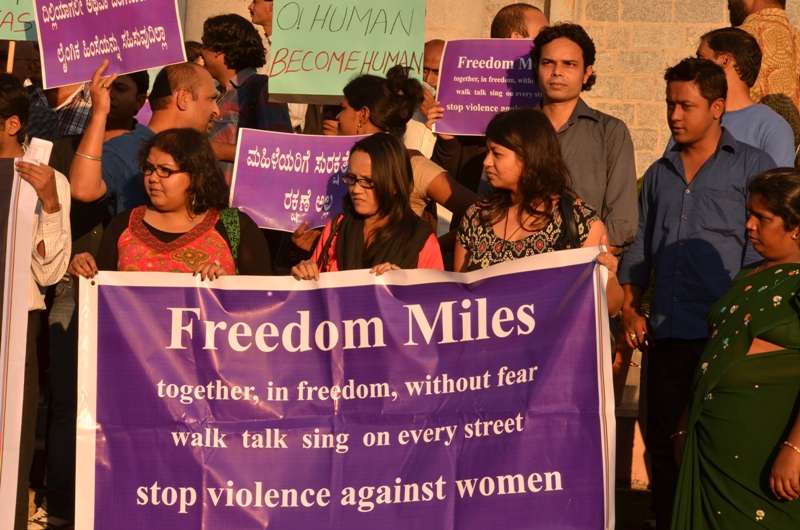It is a curious situation. Groups and individuals who for decades have been deeply concerned about all forms of violence against women, including sexual assault, and have not only consistently campaigned against such violence but also worked at different levels to provide support to and secure justice for victims/survivors, have been arguing against the death penalty recently awarded to the four men convicted of brutally raping, torturing and eventually murdering a young woman in Delhi last December.
Many others, who clearly have far less exposure to and expertise in the complex matter of gender-based violence in general and sexual violence in particular, but were obviously shocked and shaken by the extreme cruelty involved in the crime that quickly became a nationwide and international cause celebre, have not only celebrated it but also aggressively promoted the eye for an eye school of jurisprudence (dating back to 1700 BC or thereabouts) as the only way to ensure both justice and prevention.
Despite several attempts by the former to explain their information and experience-based opposition to the death penalty . not only on moral/ethical grounds but also practical knowledge of prevailing legal and judicial processes . many of the latter are obviously not interested or convinced (or both).
The Justice Verma Committee, set up by the government soon after the notorious gang-rape in Delhi and tasked with recommending legal reforms to effectively tackle crimes involving sexual assault, had rejected the notion that capital punishment serves as a deterrent. Unfortunately, however, the controversial Criminal Law (Amendment) Act, 2013 . supposedly based on the Committee's widely acclaimed report and passed by both houses of Parliament in March . included the death sentence as an option in the "rarest of rare" cases.
In the absence of a statutory definition of the term and with judicial guidelines giving presiding judges considerable latitude to determine what qualifies as "rarest of rare," it is not surprising that sentencing appears rather arbitrary, often seemingly influenced by "popular sentiment."
Impassioned, impatient debates
Sections of the media have been leading the charge towards the death penalty, especially since December 2012. There is little doubt that the relentless, emotive, campaign-style coverage and impassioned, impatient television debates have contributed to the manufacture of consent over the desirability of the death penalty, especially in high-profile cases.

•
Justice Verma's recommendations
•
Myths about the death penalty
Ironically, media fury over selected cases . typically restricted to exceptionally violent crimes against urban, middle-class victims and/or committed by members of the underclass . does not necessarily result in sensitive, responsible coverage. In the case of the gang-rape of a young woman media professional in Mumbai in August 2013, despite widespread public shock and anger, even some of the supposedly sympathetic reporting was unacceptably intrusive.
Meanwhile, those demanding "stringent punishment" in extensively reported cases of sexual assault . within the media and elsewhere . appear impervious to a large number of other such crimes. Earlier this month the online magazine, India Resists, published a list of 101 cases of brutal violence against Dalit women reported between 16 December 2012 (the date of the gang-rape in Delhi) and 31 August 2013 (when Asaram Bapu, the "sant" accused of sexually assaulting a young girl, was finally detained). Compiled by Arun Khote and headlined, Casting Rape: 101 Cases of Sexual Violence Against Dalit Women After Damini that Failed to Generate Mainstream Outrage, the feature posed the legitimate question: "Why do some rapes deserve anger and others do not?"
Similarly, days after the sentencing in the Delhi gang-rape case, Tehelka featured a story by Priyanka Dubey on The Forgotten Rape Stories. The article highlighted several other horrific cases of sexual assault that had grabbed headlines for a while, but seem to have faded from public memory while the women and girls involved, including a badly injured five-year-old, continue to suffer physically, emotionally and socially while awaiting justice.
Multiple manifestations
Many of those celebrating the death sentence handed down on 13 September also seem unaware of and relatively unconcerned about the wide range of other forms of violence women routinely experience, many of which are as traumatic and potentially damaging as sexual violence. It is interesting that sections of the media that have been in the forefront of the crusade for the death penalty in the December 2012 case barely took note of the statement issued by Rashida Manjoo, UN Special Rapporteur on Violence against Women, its Causes and Consequences, at the end of her first official country mission to India between 22 April and 1 May 2013.
The mission included meetings in New Delhi, Rajasthan, Gujarat, Maharashtra and Manipur and, in addition, gathered information from other states. Several women's groups and activists working on gender-based violence interacted with the Special Rapporteur and many individual women shared personal experiences of violence and survival with her. A comprehensive report on her findings will be presented to the United Nations Human Rights Council in June 2014.
According to the preliminary statement issued by Manjoo on 1 May, "Violence against women and girls in India manifests in numerous ways and varies in prevalence and forms based on numerous factors, including geographic location. Some manifestations include: sexual violence, domestic violence, caste-based discrimination and violence, dowry related deaths, crimes in the name of honour, witch-hunting, sati, sexual harassment, violence against lesbian, bisexual, and transgender people, forced and/or early marriages, deprivation of access to water and basic sanitation, violence against women with disabilities, sexual and reproductive rights violations, sex selection practices, violence in custodial settings and violence in conflict situations, among others."
The statement noted that while sexual harassment and violence are widespread in India . perpetrated in public spaces, in the family, as well as in the workplace . there is a generalised sense of insecurity in public spaces, amenities and transport facilities, where women are often victims of different forms of sexual harassment and assault.
The statement highlighted the prevalence of conflict-related sexual violence in several places within the country, pointing out that it is crucial to acknowledge that such violations occur at the hands of both state and non-state actors. It also focused attention on the multiple forms of discrimination and violence suffered by women from Dalit and Adivasi communities, other Scheduled Castes, tribal and indigenous minorities. The vulnerability of domestic workers, who are often victims of various acts of violence, including sexual harassment and abuse, by their employers and others, is another dimension of violence against women highlighted in the statement.
In addition, numerous testimonies flagged the continuing reality of customary and religious practices such as child marriages and dowry-related practices, sorcery, honour killings, witch-hunting of women, and communal violence against women. According to the statement, the latter was obviously of particular concern to many since "the wounds of the past are still fresh for women who were beaten, stripped naked, burnt, raped and killed because of their religious identity, in the Gujarat massacre of 2002."

Protests in Bangalore after the death of the student gang-raped in Delhi.
Credit: Jim Ankan Deka via Wikimedia
How long is too long?
The proponents of retributive justice in cases that gain prominence (thanks primarily to intense media attention) seem to have little patience for the argument that the law and order, crime and punishment approach, while undoubtedly important and necessary, cannot and will not . by itself . reduce or reverse the evidently growing incidence of violent crimes against women in India, including sexual assault. The counter-argument asserts that there is no time for a more long-term, holistic approach that simultaneously tackles the prevailing gender-based discrimination, oppression and violation of fundamental human rights of which violence, including sexual violence, is a particularly odious and troubling symptom.
The fact is, however, that the contemporary struggle against gender-based violence, including sexual assault, did not begin in December 2012. The first widespread public campaign against rape in India, triggered by a Supreme Court judgement in what is known as the Mathura rape case (involving the custodial rape of a young tribal girl by two policemen within a police station in Maharashtra), began in 1980 and led to important, if inadequate, changes in the law relating to sexual assault.
If the government and other institutions of society (not only women's organisations) had invested more time and effort over the decades since then in at least attempting to do all that it takes to create a more gender-just society, dismantle false and harmful notions of masculinity and femininity, nurture a positive, healthy understanding of sexuality, educate boys and girls on gender equality and mutually respectful gender and sexual relations, maybe . just maybe . the situation would have been somewhat different by now.
The voice of experience
It is surely note-worthy that almost everyone who has done sustained and serious work on gender-based violence, including sexual assault, agrees that there is no easy or quick solution to what is a gigantic and entrenched problem. The World Health Organisation, which released a report on the subject in June 2013, describes physical or sexual violence as a global public health problem of epidemic proportions that affects more than one third of all women across the world.
Welcoming the Indian government's speedy response in the aftermath of the December 2012 gang-rape in Delhi, the UN Special Rapporteur on Violence against Women regretted the fact that the amendments to the law relating to sexual assault did not "fully reflect the Justice Verma Committee's recommendations."
According to her, "It is unfortunate that the opportunity to establish a substantive and specific equality and non-discrimination rights legislative framework for women, to address de facto inequality and discrimination, and to protect and prevent against all forms of violence against women, was lost. The speedy developments and also the adoption of a law and order approach to sexual wrongs, now includes the death penalty for certain crimes against women. This development foreclosed the opportunity to establish a holistic and remedial framework which is underpinned by transformative norms and standards, including those relating to sexual and bodily integrity rights. Furthermore, the approach adopted fails to address the structural and root causes and consequences of violence against women."
Echoing what countless women's rights activists in India and across the world have been saying for years and have reiterated over the past several months, Ms. Manjoo ended her statement with these words: "A legislative and policy approach will not bring about substantive change if it is not implemented within a holistic approach that simultaneously targets the empowerment of women, social transformation, and the provision of remedies that ultimately address the continuum of discrimination and violence, and also the pervasive culture of impunity."
If we as a society are serious about reducing, if not eliminating, gender-based violence the first step towards a solution is to take the opinions of people who
have been working on the issue for several decades more seriously.
























